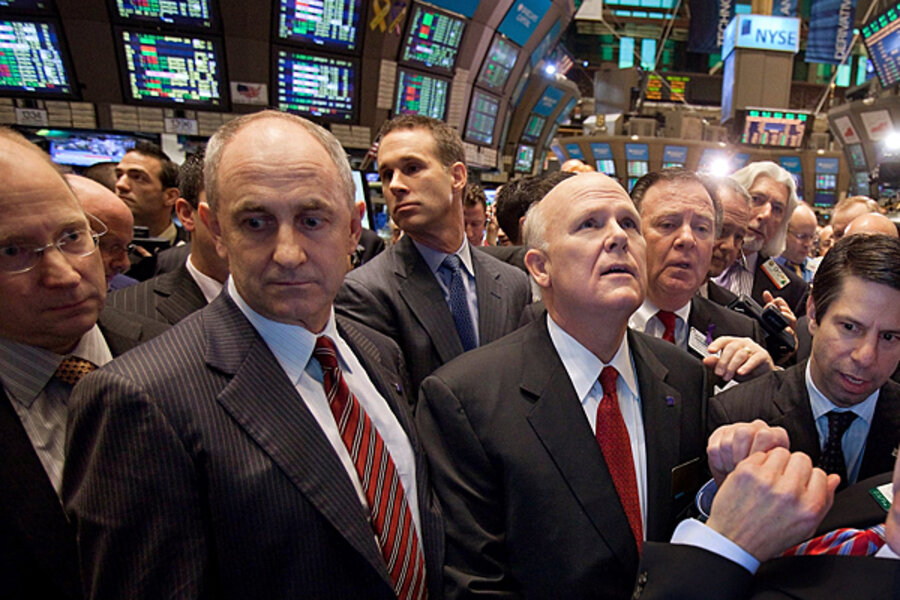GM stock price up 3.6 percent on first day: five questions about the IPO
Loading...
| Detroit
General Motors began selling shares of company stock again Thursday, 17 months after the company declared bankruptcy and its previous shares became virtually worthless.
The initial public offering (IPO) is designed to shore up cash to assist in the company’s continuing recovery after its bailout, but more importantly, the IPO puts the company on track to pay back the federal government’s $49.5 billion investment.
Some questions and answers on the IPO:
What is the GM stock price and how did the company arrive at that number?
Shares of the stock started selling Thursday at $35 per share and the GM stock price hit a daily high of $35.99 by noon, before finishing the day at $34.19, up 3.6 percent from the IPO price of $33 per share. The IPO price was raised from the $26-29 range analysts had predicted earlier this month.
The increase in the initial share price was likely a result of perceived high demand for the stock and third quarter numbers released last week that reported $2 billion in earnings and an increase from the previous two quarters. (The company earned $4.2 billion in the first nine months of 2010.) Bolstering expectations was GM’s forecast of a profitable fourth quarter as well, resulting in the company’s first full year of profits since 2004.
Company executives used the good news to help drive home a message to investors and the media that says GM can be profitable at roughly half the vehicle sales volume of past years, thanks to plant restructuring and deep cuts in its labor force and dealership network. In a video sent to reporters last week, chief financial officer Christopher Liddell announced GM could earn as much as $11-13 billion a year under normal market conditions, a forecast that no doubt is being used to hike up its share price.
How much stock is being offered and who is expected to buy it?
GM is offering stockholders 365 million shares; 250 million shares traded hands by noon Thursday and more than 450 million shares by closing. The stock is being offered both on the New York Stock Exchange and the Toronto Stock Exchange to investors ranging from major mutual funds in the US to foreign investors in the Middle East and Asia. GM has an option to sell more shares.
How much cash does GM hope to raise?
The GM IPO is the largest in history. The company raised $23.1 billion, about 5 percent higher than the $22.1 billion generated by Agricultural Bank of China in their IPO conducted in July.
Why 17 months after the bailout? Shouldn’t the company have waited to prove it was profitable over a longer term?
Besides enduring the scrutiny of the federal government, GM also has had to contend during the last year and a half with negative public perception – summed up by a “Government Motors” moniker – that threatens its long-term profitability. Despite evidence it helped save the company from collapse, the bailout “never got the respect of the customer,” says Sean McAlinden, chief economist for the Center for Automotive Research in Ann Arbor, Mich. “The customer does not want to buy a car mandated and controlled by the government.”
The move was timed to take advantage of the company’s profitable rise this year, but it follows months of discussions between the automaker and the government task force in charge of restructuring. Both sides are anxious to move forward. GM wants to win back consumer confidence once the economy picks up, and the government wants to assure taxpayers they will recover the full investment plus interest and dividends.
What is a realistic timetable for the federal government to exit its ownership role of the company?
Because the government has the largest allocation of shares, cutting ties with the company will not be swift. Thursday’s IPO was designed to diminish the US Treasury Department’s majority ownership from 61 percent to between 26 to 33 percent. The Treasury Department has said it plans to sell more shares in as soon as six months. Analysts say the government is watching the market to gauge the right opportunity, which means its remaining holdings will not likely be sold in a single sale. A more realistic forecast for the government to exit GM completely is two years.





